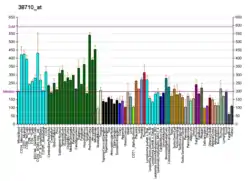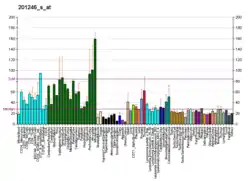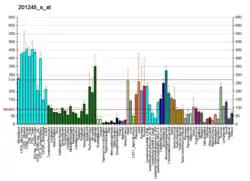OTUB1
Ubiquitin thioesterase OTUB1 also known as otubain-1 is an enzyme that in humans is encoded by the OTUB1 gene.[3][4] Alternative splicing results in multiple transcript variants.
Function
Otubain-1 is a member of the OTU (ovarian tumor) superfamily of predicted cysteine proteases. The encoded protein is a highly specific ubiquitin iso-peptidase, and cleaves ubiquitin from branched poly-ubiquitin chains, being specific for lysine48 -linked polyubiquitin but not lysine63 -linked polyubiquitin.[5] It interacts with another ubiquitin protease and an E3 ubiquitin ligase that inhibits cytokine gene transcription in the immune system. It is proposed to function in specific ubiquitin-dependent pathways, possibly by providing an editing function for polyubiquitin chain growth.[4]
References
- GRCh38: Ensembl release 89: ENSG00000167770 - Ensembl, May 2017
- "Human PubMed Reference:". National Center for Biotechnology Information, U.S. National Library of Medicine.
- Balakirev MY, Tcherniuk SO, Jaquinod M, Chroboczek J (Apr 2003). "Otubains: a new family of cysteine proteases in the ubiquitin pathway". EMBO Rep. 4 (5): 517–22. doi:10.1038/sj.embor.embor824. PMC 1319179. PMID 12704427.
- "Entrez Gene: OTUB1 OTU domain, ubiquitin aldehyde binding 1".
- Edelmann MJ, Iphöfer A, Akutsu M, Altun M, di Gleria K, Kramer HB, Fiebiger E, Dhe-Paganon S, Kessler BM (March 2009). "Structural basis and specificity of human otubain 1-mediated deubiquitination". Biochem. J. 418 (2): 379–90. doi:10.1042/BJ20081318. PMID 18954305.
- Soares L, Seroogy C, Skrenta H, Anandasabapathy N, Lovelace P, Chung CD, Engleman E, Fathman CG (January 2004). "Two isoforms of otubain 1 regulate T cell anergy via GRAIL". Nat. Immunol. 5 (1): 45–54. doi:10.1038/ni1017. PMID 14661020. S2CID 27005972.
Further reading
- Maruyama K, Sugano S (1994). "Oligo-capping: a simple method to replace the cap structure of eukaryotic mRNAs with oligoribonucleotides". Gene. 138 (1–2): 171–4. doi:10.1016/0378-1119(94)90802-8. PMID 8125298.
- Suzuki Y, Yoshitomo-Nakagawa K, Maruyama K, et al. (1997). "Construction and characterization of a full length-enriched and a 5'-end-enriched cDNA library". Gene. 200 (1–2): 149–56. doi:10.1016/S0378-1119(97)00411-3. PMID 9373149.
- Makarova KS, Aravind L, Koonin EV (2000). "A novel superfamily of predicted cysteine proteases from eukaryotes, viruses and Chlamydia pneumoniae". Trends Biochem. Sci. 25 (2): 50–2. doi:10.1016/S0968-0004(99)01530-3. PMID 10664582.
- Zhang QH, Ye M, Wu XY, et al. (2001). "Cloning and functional analysis of cDNAs with open reading frames for 300 previously undefined genes expressed in CD34+ hematopoietic stem/progenitor cells". Genome Res. 10 (10): 1546–60. doi:10.1101/gr.140200. PMC 310934. PMID 11042152.
- Borodovsky A, Ovaa H, Kolli N, et al. (2003). "Chemistry-based functional proteomics reveals novel members of the deubiquitinating enzyme family". Chem. Biol. 9 (10): 1149–59. doi:10.1016/S1074-5521(02)00248-X. PMID 12401499.
- Strausberg RL, Feingold EA, Grouse LH, et al. (2003). "Generation and initial analysis of more than 15,000 full-length human and mouse cDNA sequences". Proc. Natl. Acad. Sci. U.S.A. 99 (26): 16899–903. doi:10.1073/pnas.242603899. PMC 139241. PMID 12477932.
- Soares L, Seroogy C, Skrenta H, et al. (2004). "Two isoforms of otubain 1 regulate T cell anergy via GRAIL". Nat. Immunol. 5 (1): 45–54. doi:10.1038/ni1017. PMID 14661020. S2CID 27005972.
- Ota T, Suzuki Y, Nishikawa T, et al. (2004). "Complete sequencing and characterization of 21,243 full-length human cDNAs". Nat. Genet. 36 (1): 40–5. doi:10.1038/ng1285. PMID 14702039.
- Colland F, Jacq X, Trouplin V, et al. (2004). "Functional proteomics mapping of a human signaling pathway". Genome Res. 14 (7): 1324–32. doi:10.1101/gr.2334104. PMC 442148. PMID 15231748.
- Gerhard DS, Wagner L, Feingold EA, et al. (2004). "The status, quality, and expansion of the NIH full-length cDNA project: the Mammalian Gene Collection (MGC)". Genome Res. 14 (10B): 2121–7. doi:10.1101/gr.2596504. PMC 528928. PMID 15489334.
- Rual JF, Venkatesan K, Hao T, et al. (2005). "Towards a proteome-scale map of the human protein-protein interaction network". Nature. 437 (7062): 1173–8. doi:10.1038/nature04209. PMID 16189514. S2CID 4427026.
- Juris SJ, Shah K, Shokat K, et al. (2006). "Identification of otubain 1 as a novel substrate for the Yersinia protein kinase using chemical genetics and mass spectrometry". FEBS Lett. 580 (1): 179–83. doi:10.1016/j.febslet.2005.11.071. PMID 16364312. S2CID 24766989.




